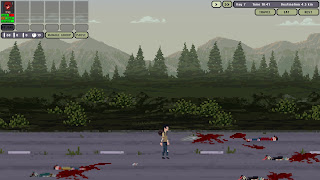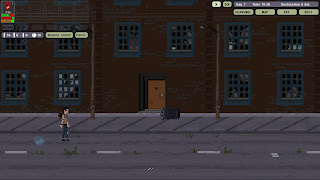 |
| Not quite the cruellest month. |
No, it's got nothing to do with the Holocaust education program... it's a rogue-lite zombie indie game by Machine 22, available on Steam. Yeah. Not sure they thought that one through. Anyway, this came to my attention because I saw Splattercat playing it. I can recommend Splattercat; I started watching him at random when another indie game, The Forest, came out, and he's the only "Let's Play"-er I watch, mostly because his affable raconteur style, deriving apparently from radio experience, and his academic background, make him appealing to my sensibilities. Similarly, I like atmospheric, emergent storytelling games with pixel artwork graphics, and despite how overdone they are now zombie survival scenarios still interest me, so I kept an eye on March of the Living until it was on sale. The gameplay is obviously, and I believe quite deliberately, reminiscent of FTL: Faster Than Light, except that in March of the Living instead of controlling a spaceship flying through space you're, as is so often the case in zombie games, some guy walking across post-apocalyptic America. You move across a map from point to point and whenever you get to a new point you have some kind of encounter.
 |
| This is Greg. He is both marching and alive. |
The encounters are more or less the heart of March of the Living. They range from fairly straightforward situations, like finding a place trading supplies or accidentally running into a bunch of zombies you have to fight, to more bizarre ones like finding a hole filled with zombies covered in petrol just waiting to be immolated or a travelling rock band that offers to play you music in return for food. Some of these encounters I found quite atmospheric and mysterious, like one involving seeing a strange girl with an axe in the distance; if you hang back and watch her, she just walks away. Some are rather clichéd and predictable, like one presenting a run-in with a couple who offer you free food which of course turns out to be cooked human flesh. Some I found affected, trying too hard to be cool, like one featuring a well-dressed man with heavily-armed butlers who appears out of nowhere and asks you if you have any collectible bobbleheads.
 |
| "We got this, man! We got this by the ass!" |
I hate to say it, however, but the biggest problem with these encounters is that there simply aren't enough of them. March of the Living is quite a difficult game, and when you die you have to go back to the beginning. I've seen the same encounters repeatedly, and very rarely see new ones. That wouldn't be so bad if there were more options, but sometimes there is only one way to respond to an encounter; often a second option is greyed-out and unclickable unless you have a particular item that you might have arbitrarily found earlier in the game. As such, a game of March of the Living can easily become repetitive and monotonous, especially if you recognise the encounters you've seen before. Maybe I haven't made enough progress yet but personally I think a game with emergent storytelling like this needs a good deal more content, and perhaps some procedurally-generated content so that certain encounters themselves have randomly-allocated variants to keep things fresh.
 |
| What a glorious feeling. |
This would also be a little more tolerable if the art was a bit more varied. March of the Living has a few "travelling between marks on the map" backgrounds and a few "in cities" backgrounds but little else in the way of dressing. Sometimes you'll come across a unique location like a lake or a log cabin, but these are rare. When moving between markers you watch the character sprite walking in front of a background, and it would be nice if these had more variety. For instance, if moving between a normal marker and a city it would be good if buildings started to appear, or the reverse if walking away from a city. Similarly, in some of the encounters it would be nice if you could see your character and a few other sprites to give you a sense of the scene. This wouldn't work for all of them, like the mysterious axe-wielding girl, but at other times it would; a campfire with a few people sitting around it, perhaps, or a couple of guys arguing by the side of the road. Judicious use of additional artwork would enhance the atmosphere where appropriate. If it was possible to have encounters in cities it would also enhance the variety. Furthermore, I think it would be more visually appealing if the map screen looked like an actual map rather than just a bunch of lines criss-crossing on a grey space, sort of like the star map in FTL.
 |
| Move the glow. |
Speaking of cities, the other major element of March of the Living is the survival and combat. Your player characters need food and rest, and if attacked by zombies or, rarely, other people, they have to fight, so you also need to keep hold of weapons, bullets and medical supplies. Each character has different abilities and combat proficiencies with the game's four kinds of weapons: close combat weapons, pistols, rifles and shotguns. Much like FTL you can pause during combat to pick targets and weapons have a timed bar which fills up before they are ready to fire. It's straightforward but at times feels simplistic and lacking in nuance, as battles take place in empty rectangles with the player characters, the zombies or human enemies and no obstacles or environmental depth. In FTL this made sense as the game was set in space, but March of the Living is not, and at times it feels overly reductive and lacking the flexibility and customisable nature of a game like FTL.
 |
| Sure is flat in this part of the USA. |
The survival aspect is a little better but still lacks nuance. There are different health items that allow you to heal to different degrees, but only generic food rations which always restore your hunger to full. There's an encounter featuring nicking a bunch of cooked rabbits from an unsupervised campfire which always makes me think that my guy is going to get malnutrition from eating them (digesting rabbit uses more vitamins and so on than it restores), but that isn't part of the game, although you can get the zombie disease from eating an infected deer. When you character is fully fatigued you suffer combat penalties so it's good to rest, but for some reason it's only completely safe do so in city areas. If you do it in the countryside between encounters you risk getting attacked by zombies while you sleep. This makes no sense to me; surely there would be far more zombies in the cities than out in the countryside where the population is so much lower. It's possible to get attacked by zombies in both the country and city, but in the country it seems fairly random. There is a "growls" meter at the top of the screen that fluctuates, I think telling you how many zombies you can hear nearby, suggesting that if you get attacked there will be more, but as far as I can tell you can't do anything about it, so I'm not sure what the point is. If there is a point, the game doesn't explain it; I don't recall it being explained in the tutorial.
 |
| I bet there are loads of broken umbrellas in the zombie apocalypse. |
Getting attacked by zombies in the city is what can happen when you scavenge, which you can only do in cities. You can select a certain amount of time to scavenge for in various locations, and the longer you scavenge the more likely you are to get attacked; you are informed of the percentage likelihood of being attacked. If you are attacked, you need to fight the zombies before you can get any supplies (and you don't always even get supplies) but there are usually so many that it's unlikely to be worth it. You can also flee from the zombies but you lose time, can't loot that location and risk losing items. Anything can be lost as well, no matter how unlikely it might be. If you flee in the country you go back to your last visited location. In the city, the places you can loot offer different items. The police station tends to provide ammunition, the hospital might have medical supplies, the grocery store may have food, the drug store seems to have fairly random things and the apartments often have items that are only useful in encounters. Sometimes this can work in your favour and sometimes it doesn't, and unlike, say, Organ Trail, you don't have too much control over it.
 |
| Somewhere in this picture, Greg is sleeping. |
There are four storylines in the game but you have to finish each one to unlock the next. I'm still going on the first, so maybe I haven't seen all the game has to offer, but so far it feels a tad limited. Aspects of it feel like a stripped-down FTL and aspects feel like a stripped-down Organ Trail. I don't mean to be too harsh, but I always feel a little surprised when I remember that the game isn't Steam Early Access; it's a full release. The problem, I would argue, is that the game's got a solid foundation, with decent writing, nice art and functional gameplay, but it needs a little more. A touch more artwork and story/encounter content would keep the rogue-lite nature engaging and somewhat more complexity to combat and survival would make the gameplay more exciting. If I was to give some unsolicited advice to the developer I would say that he should develop this game a little further in an update or (preferably free) downloadable content, or build on the experience of this game to develop a more complex title in future. When a solid foundation exists, which this game undoubtedly has, it is an opportunity to be seized, like the horrible cadaverous hands of a pixelly zombie on a victim's reluctant neck.
No comments:
Post a Comment
Note: Only a member of this blog may post a comment.